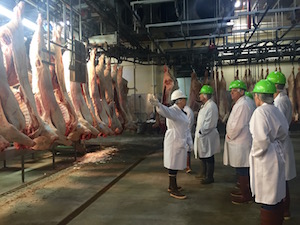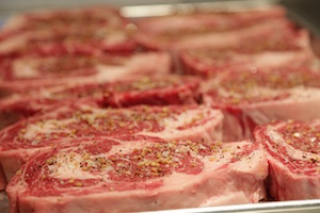Courtesy of Agri Beef
Less than 30 miles from the Canadian border spanning 70,000 breathtaking acres of the Okanagan region of Washington state sits Double R Ranch. Rooted in more than a century of ranching tradition, it is the heart and soul of family-owned and operated Agri Beef, producer of premium beef under the Snake River Farms, Double R Ranch, St. Helens and Rancho El Oro brands. This past summer, the ranch hosted a half-dozen culinary educators from around the country to provide an up-close view of the ranch-to-table beef lifecycle.
“As a chef for many years studying beef, looking at beef, dealing with beef from the consumer end, this was a really unique opportunity to be able to come out to the ranch and take the whole process from beginning to end,” said Randall Sansom, chief academic officer of the Auguste Escoffier School of Culinary Arts.
 The day on the ranch was just one stop on the tour, as Agri Beef is involved in every step of the beef lifecycle – from cattle feeding through processing and distribution –from ranch to table, literally.
The day on the ranch was just one stop on the tour, as Agri Beef is involved in every step of the beef lifecycle – from cattle feeding through processing and distribution –from ranch to table, literally.
Sansom observed, “To be able to see the care and love the animals are shown from the very beginning, the pride the ranchers take in producing their product all the way down to the processing plant, you can see the integrity of each person’s work in order to produce a truly outstanding product...it's in everyone's best interest to have the actual real information out there.”
Realizing not everyone can travel to the Northwest to experience a ranch-to-table tour and the insights it brings, Agri Beef has now brought the tour to them by developing a free online education program for chefs, culinary educators and students nationwide.
The Ranch to Table program is the first of its kind to offer a comprehensive lifecycle view of how responsible, high-quality beef arrives at tables across the world from ranches in the Northwest.
“Now more than ever consumers have a curiosity and interest in knowing where their food comes from and how it is raised,” said Jay Theiler, executive director of Marketing at Agri Beef. “We recognize that chefs and culinary professionals are the trusted sources for diners and shoppers, so we created this resource to supplement their existing knowledge and give greater insight into our industry and how beef gets to their prep tables.”
In developing the program, Agri Beef collaborated with culinary educators from across the country to address topics that complement their courses. The four self-paced modules cover:
Ranching
High-quality beef begins at the ranch. Selecting the best cattle, treating them with care and respect, providing a healthy diet and caring for the environment are critical to raising the highest quality beef.
Cattle Feeding
The cattle continue to be cared for in the low-stress environment of the feed yard. They are fed a balanced diet formulated for the health of the cattle and the quality of the beef.
Beef Processing and Grading
We take great responsibility to ensure the humane treatment of cattle through final processing. Multiple food safety steps and a sophisticated grading system prepare the carcass for fabrication.
Beef Fabrication and Distribution
Follow the beef carcass onto the fabrication floor where it is broken down into primals and subprimals by trained butchers who take great care to ensure it is done to the highest standard for packaging and distribution.
“I think the modules could really supplement in some areas and augment in other areas the information we already provide,” said David Miles, director of operations for the New England Culinary Institute. “My class rotation is pretty quick, so the opportunity to pull modules and teach some in the first year and some in the second would really be great. The level of detail is something that students really will appreciate and at this point, I don't want to say is completely off their radar, but is an area where there is a lot of opportunity to get them good information on the front end.”
Leaders at Agri Beef point to their commitment to transparency as a guiding force in developing this program. As Scott Steffanelli, chef instructor at the Culinary Institute of Charleston, noted, “I think this is what the project is about – transparency. It’s about what really is the beef industry, what is the backstory? I try to do that in the classroom so students can understand it and be informed consumers because ultimately, they're going to be on the front lines making these decisions and they're going to be impacting what people eat and what's on people's plates. I think that's where the program can have some impact. What's the true story and what's the end game to the ranching industry and the beef industry? And what chefs do with the product once they get it and how that all connects.”
The program is designed for both personal development and as a classroom-training tool and is available via the Agri Beef website http://www.agribeef.com/education powered by the Escoffier Culinary School online platform. Upon completion of the course, participants are eligible for 15 Continuing Education hours through the American Culinary Federation and also receive access to the materials – PowerPoint slides, instructor notes, student assessments and other beef industry resources - for use in their culinary classrooms.
The Agri Beef team welcomes feedback on their first foray into culinary education, and on what areas of information they can improve on or explore next. The company plans to develop more resources to complement the knowledge and expertise of culinary and industry partners. As to the early feedback on the Ranch to Table program, restaurant and culinary school consultant Chef Paul Sorgule of Harvest America Ventures noted, “With the thoughtful approach that went into developing this robust resource, I am confident that it will help to make a difference in culinary education.”
Photos courtesy of Agri Beef.
